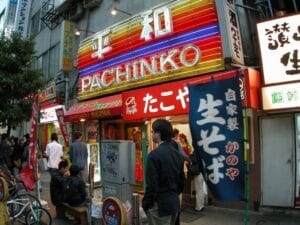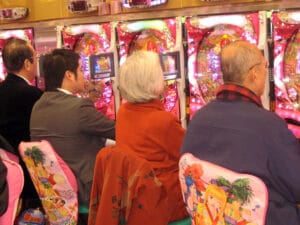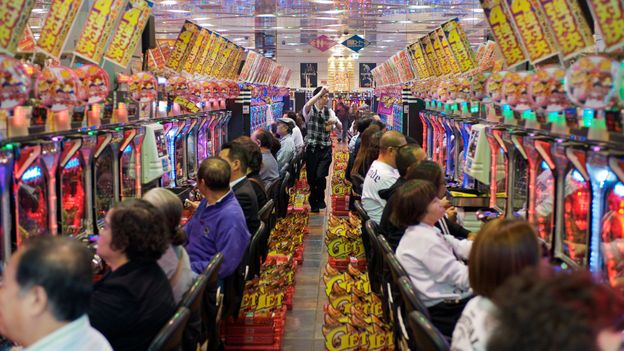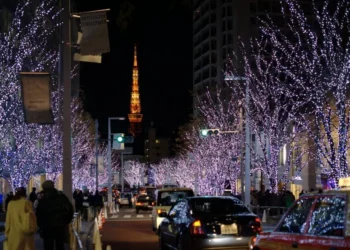No products in the cart.
The History and Influence of Pachinko Parlors: Gambling, Addiction, and Its Dark Ties
Introduction: Pachinko Parlors
Pachinko is a cultural icon in Japan, straddling the line between entertainment and gambling. Though it may resemble a slot machine or pinball hybrid, the game occupies a unique place in Japanese society. For some, it’s a harmless form of recreation. For others, it’s a gateway to addiction, with serious societal and economic consequences. Additionally, pachinko has long been rumored to have ties to the underworld, making it a complex industry with deep, sometimes troubling roots. This article will delve into the history of pachinko, its connection to gambling addiction, its suspected ties to organized crime, and how it contrasts with traditional casinos.
The Evolution of Pachinko: From Post-War Diversion to National Pastime
Pachinko’s roots trace back to the early 1900s, but its rise to prominence came after World War II. In the aftermath of the war, Japan was undergoing significant reconstruction, and people sought affordable distractions from the tough realities they faced. Modeled initially after western pinball machines, pachinko soon transformed into its own unique game. Players launch small steel balls into the machine, which bounce through a series of pegs and obstacles. The goal is to land the balls in certain pockets to release additional balls, which players can trade for prizes.
During post-war recovery, pachinko parlors began popping up across the country, providing inexpensive entertainment for the public. It was a brief, colorful escape from the hardships of the time, but over the years, pachinko evolved into much more. Today, Japan is home to thousands of pachinko parlors, attracting millions of players each year. These neon-lit halls, filled with flashing lights and the constant sound of steel balls clinking, have become a fixture of Japanese urban culture. The game’s addictive nature continues to draw both devoted regulars and curious newcomers, solidifying pachinko as a significant part of Japan’s leisure landscape.

Pachinko: Entertainment or Gambling? The Blurred Lines
Although Japan outlaws most forms of gambling, pachinko manages to skirt these laws by functioning in a legal gray area. Instead of awarding players cash, pachinko machines dispense small prizes or tokens. These can then be exchanged for money at separate locations, allowing the game to technically comply with the country’s strict gambling regulations.
Despite being marketed as entertainment, for many people, pachinko feels much like traditional gambling. Players often spend long hours and large sums of money on the machines, hoping for a big win. The ability to swap tokens for cash gives pachinko the financial appeal of gambling, making it more than just a casual game.
Pachinko and Gambling Addiction: A Growing Problem
Pachinko’s addictive nature is one of its most controversial aspects. While some can enjoy pachinko parlors casually, many become trapped in the cycle of addiction. The flashy lights, loud sounds, and quick rewards are designed to stimulate the brain, keeping players engaged. Similar to slot machines in casinos, pachinko machines operate on a system of variable rewards, which keeps players hooked, even when they are losing money.
The addiction crisis in Japan is significant. Millions of yen are lost every year by pachinko players who cannot break free from their addiction. This often leads to financial problems, strained relationships, and even crime, as some individuals resort to illegal means to fund their addiction.
Pachinko addiction has also raised concerns about mental health in Japan, where the stigma around seeking help for such issues is still strong. Many addicted players may not seek treatment or counseling, leading to an ongoing cycle of dependency on the game.

Ties to the Underworld: Organized Crime and Pachinko
For decades, pachinko parlors has been rumored to have connections to the Japanese underworld, particularly the yakuza, Japan’s organized crime syndicates. While there is little concrete public evidence, many believe that the scale of the industry, the vast amounts of money exchanged, and the network of off-site cash exchange shops make it ripe for corruption and illegal activity.
The pachinko industry is believed to be involved in money laundering and other illicit activities, with certain parlors allegedly run or influenced by yakuza groups. These groups reportedly use pachinko parlors to launder money and extort businesses, while also benefiting from the cash flow generated by addicted players.
The sheer size and power of the pachinko industry have made it difficult for authorities to regulate effectively. Despite occasional police raids and crackdowns, the industry remains largely unscathed and continues to thrive, further fueling speculation about its ties to organized crime.
How Pachinko Differs from Traditional Casinos
While pachinko shares some similarities with traditional casinos, it is distinct in several ways. The most significant difference is the legal loophole that allows pachinko to exist in Japan, where casinos are otherwise banned. Pachinko parlors operate under the guise of amusement centers, while casinos are explicitly designed for gambling, with clear monetary rewards.
In casinos, games such as poker, blackjack, and slot machines are the primary attractions. These games are straightforward forms of gambling, where players wager money with the hopes of winning more. In contrast, pachinko offers a more complex system of rewards and prizes, which are then indirectly converted into cash.
The atmosphere of pachinko parlors is also markedly different from that of casinos. While casinos often exude luxury and exclusivity, pachinko parlors are loud, chaotic, and overwhelming, with rows of machines flashing and beeping. They attract a different demographic, with pachinko being more accessible to everyday people rather than high rollers.
Additionally, pachinko’s link to addiction is often more subtle than the overt gambling seen in casinos. Because the prizes can be exchanged for cash off-site, players may not immediately realize they are engaging in gambling, further blurring the lines between entertainment and addiction.
Conclusion: A Complex Industry with Deep Roots
Pachinko remains a controversial but essential part of Japanese society. Its history, dating back to the post-war era, reflects the resilience of a country rebuilding itself. However, beneath the surface lies a much darker reality. The game’s ties to addiction, organized crime, and the exploitation of legal loopholes make it a complicated issue for Japan. While it differs from traditional casinos in certain ways, it has undoubtedly become Japan’s version of gambling.
As the pachinko industry continues to evolve, the government will likely face increasing pressure to regulate it more strictly, both to protect vulnerable players and to sever any remaining ties to organized crime. Until then, pachinko parlors will continue to light up Japan’s streets, enticing players with the promise of rewards while hiding the true cost of addiction and corruption.










